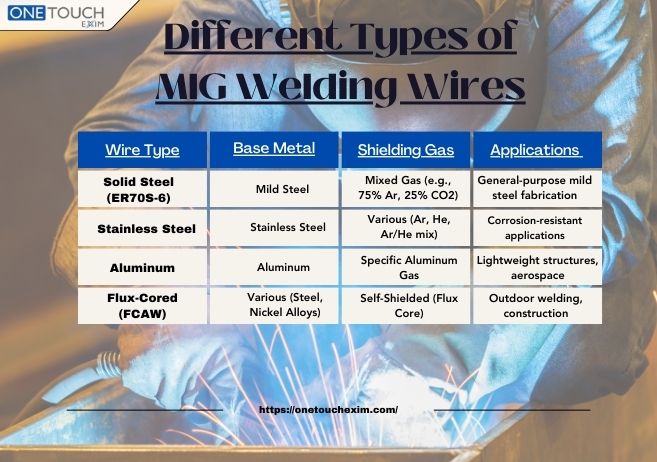MIG welding wire consists of a spooled-up electrode that satiates through a MIG welding “gun” and is heated to melt metal and join workpieces together. This process sounds simple enough, right? It’s not as simple as it sounds. There are different types of MIG welding wire, and in this blog, we’ll explain some of the major differences between them, what things we have to consider when choosing welding wire, and the importance of choosing the quality of the wire.
What is MIG Welding Wire?
MIG welding is a type of welding wire in which an arc welding technique combines two foundational components by continually delivering a solid wire electrode into the pool of weld material using a welding gun. A shielding gas is also sent through the welding gun to keep contaminants out of the weld pool. Metal inert gas is what MIG stands for. MIG Welding Wire is made from a variety of materials including aluminum welding wire, stainless steel welding wire, copper, and silver, to name just a few. There are many varieties of welding wire MIG. In this blog, we’ll go over some of the variations, factors to take seriously, and how important it is to select high-quality wire. Choosing the right MIG welding wire depends on several factors: Base Metal, Material Thickness, Shielding Gas, and Application.
What are the uses of MIG Welding Wire?
Metal components are joined together via MIG welding. It is used to unite forged iron, aluminum, stainless steel, and steel. Sheet metal, pressure vessels, steel structures, pipelines, and automobile parts are all welded with MIG welding. It allows welders to control the wire speed, polarity, and amperage & can be used to weld various alloys and metals. As a result, MIG welding finds applications in a variety of industries, including manufacturing, aerospace, custom fabrication, construction, automotive, and shipbuilding.
Different Types of MIG Welding Wire?
There are the types Four types of MIG Welding Wire. All the four are mentioned below:
1. Solid Steel MIG Wire (ER70S-6):
The unchallenged champion for mild steel welding in the USA. This all-rounder offers a perfect balance of affordability, strength, and weldability. Conversely, solid wire electrodes are exactly what they sound like large reels of flux-free solid metal wire. Consequently, a protective gas needs to be utilized when using it. A typical shielding gas composition is 25 percent of carbon dioxide and 75 percent argon. For the prevention of degradation or welded flaws, a container enclosing the electrode’s perimeter and welding geographical area is filled with a continuous stream of gas supplied by the welding gun.
2. Stainless Steel MIG Wire:
A group of steels apart, with several grades (such 304 and 316L) meeting particular requirements including corrosion resistance—a need for US welders using stainless steel Wire.
3. Aluminum MIG Wire:
Aluminum wire is a perfect welding process, and this lightweight fighter needs a specific shielding gas. Ideal for tasks requiring a high percentage of strength to weight.
4. Flux-Cored MIG Wire (FCAW):
This wire, known as the self-shielded warrior, has a flux core that emits shield gases it while welding, removing the need for an external source. Perfect for outdoor applications or situations where the shielding gas can be disturbed by wind.
An internal “flux compound” is present in flux-core wire, a metal electrode. A substance known as gas develops as a wire melts and reacts with the welding arc, shielding the weld from oxygen, and possibly leading to weld flaws. This indicates that shielding gas isn’t necessary for this kind of wire; nevertheless, in certain situations, shielding gas may be used in addition to flux-core wire to provide even more protection.
Different Types of MIG Welding Wires:
| Wire Type | Base Metal | Shielding Gas | Applications |
| Solid Steel (ER70S-6) | Mild Steel | Mixed Gas (e.g., 75% Ar, 25% CO2) | General-purpose mild steel fabrication |
| Stainless Steel | Stainless Steel | Various (Ar, He, Ar/He mix) | Corrosion-resistant applications (e.g., pipes, tanks) |
| Aluminum | Aluminum | Specific Aluminum Gas | Lightweight structures, aerospace |
| Flux-Cored (FCAW) | Various (Steel, Nickel Alloys) | Self-Shielded (Flux Core) | Outdoor welding, construction (windy conditions) |
Conclusion
MIG welding is an arc welding technique that combines two foundational components by continually delivering a solid wire electrode into the pool of weld material using a welding gun. MIG welding is perfect for constant production rhythms because it doesn’t have to replace the electrode, It guarantees very high productivity. Flexibility also plays a deciding role, as it allows any metal to be welded and MIG welding wire size common diameters used are 0.30-inch, 0.23-inch, and 0.45-inch: 0.30-inch has usually been used in houses and motorsports applications as an all-rounder. 0.23-inch is popular for heat input resistance. 0.45-inch is used if it’s in your welding control range.
